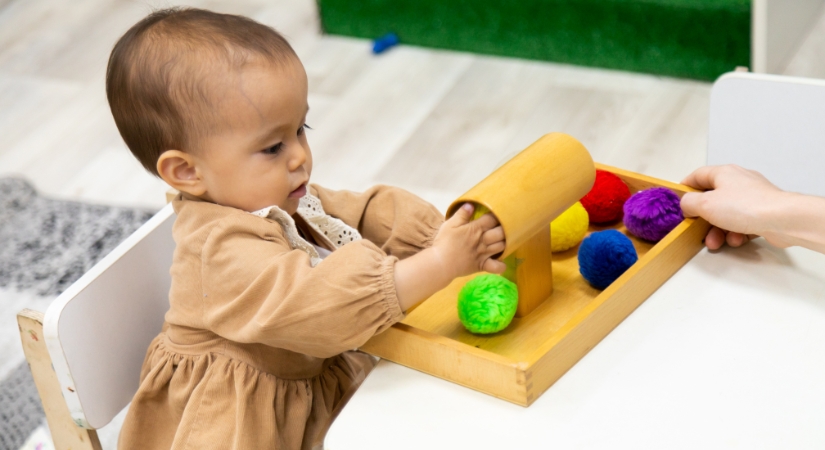Fine motor skills play a crucial role in an infant’s early development, helping them to build the coordination and strength needed for everyday tasks like grasping objects, self-feeding, and eventually writing. Engaging in activities that target fine motor skills can support cognitive development, hand-eye coordination, and overall dexterity.
Our early years experts have put together the top 10 engaging fine motor skills activities for infants.
1. Finger Painting Fun
Equipment:
- Non-toxic, washable paint
- Large sheets of paper or a wipeable mat
- Apron or old clothes
How to:
- Place the paper on a flat surface and secure it if necessary.
- Let the infant dip their fingers into the paint and explore making marks.
- Encourage different movements such as dabbing, swirling, or dragging fingers.
Developmental Benefits:
Enhances hand-eye coordination: Helps infants learn how to control their hand movements while visually tracking what they are doing.
Encourages sensory exploration: Engaging in messy play with different textures stimulates neural connections in the brain.
Strengthens finger muscles: Improves dexterity, laying the foundation for future writing skills.
2. Pincer Grasp Practice with Cereal
Equipment:
- Small, dry cereal pieces (e.g., Cheerios)
- A shallow bowl or tray
How to:
- Place the cereal pieces on a tray within the child’s reach.
- Encourage them to pick up each piece using their thumb and forefinger.
- Allow them to place the pieces into another bowl or eat them as a reward.
Developmental Benefits:
Strengthens pincer grasp: This movement is essential for skills like writing, buttoning clothes, and holding small objects.
Improves hand-eye coordination: Teaches infants to visually track and accurately pick up small objects.
Encourages focus and patience: Requires concentration and persistence, fostering problem-solving skills.
3. Ribbon Pull Box
Equipment:
- A small box with holes punched through
- Various ribbons threaded through the holes
How to:
- Securely thread ribbons through holes in the box, leaving loops exposed.
- Encourage the infant to pull the ribbons from one side to the other.
- Let them explore different textures and resistance levels.
Developmental Benefits:
Strengthens finger muscles: The resistance in pulling motions helps develop grip strength.
Encourages bilateral hand coordination: Using both hands improves overall dexterity and control.
Provides sensory stimulation: Different textures and resistances stimulate the sense of touch and spatial awareness.
4. Soft Sensory Blocks
Equipment:
- Fabric-covered soft blocks
- Different textured materials
How to:
- Provide the infant with different textured blocks to explore.
- Encourage them to squeeze, stack, and pass them between hands.
- Talk about the textures and colours to engage their senses.
Developmental Benefits:
Encourages grip strength: Holding and manipulating blocks develops strong hand muscles.
Develops hand coordination: Teaches infants how to adjust grip pressure when handling objects.
Stimulates sensory awareness: Helps babies differentiate between textures and learn about their environment.
5. Water Play with Sponges
Equipment:
- Small sponges
- A shallow tray of water
- A small bowl
How to:
- Place the sponges in the tray of water.
- Encourage the child to squeeze and transfer water between trays.
- Let them explore different amounts of pressure and movement.
Developmental Benefits:
Strengthens hand muscles: Squeezing the sponge builds endurance and grip strength.
Develops coordination: Helps refine finger control and manipulation skills.
Encourages sensory exploration: This water play activity provides an engaging hands-on experience with water resistance and texture.
6. Stacking Cups
Equipment:
- Plastic stacking cups
How to:
- Show the infant how to stack cups in order.
- Encourage them to try stacking or knocking them over.
- Experiment with different formations and sizes.
Developmental Benefits:
Develops problem-solving skills: Teaches concepts of size, balance, and spatial awareness.
Enhances hand-eye coordination: Improves precision in reaching and placing objects.
Strengthens grip and dexterity: Helps refine control over small hand movements.
7. Pom-Pom Drop
Equipment:
- Large pom-poms
- A recycled container with a hole cut out
How to:
- Show the infant how to push pom-poms through the hole.
- Let them explore placing and retrieving pom-poms.
- Encourage repetition to build confidence.
Developmental Benefits:
Encourages precision and accuracy: Helps refine movement control.
Strengthens finger and hand muscles: Promotes fine motor development needed for future writing.
Develops focus and concentration: Supports problem-solving and patience.
8. Playdough Pinching
Equipment:
- Non-toxic playdough
How to:
- Give the infant a small piece of playdough to explore.
- Encourage them to pinch, squeeze, and poke it.
- Demonstrate how to roll small balls or flatten the dough.
Developmental Benefits:
Develops pincer grasp and finger strength: Essential for writing and self-care tasks.
Encourages creativity: Allows creative self-expression through shaping and moulding.
Provides a sensory experience: Different textures and resistances enhance tactile awareness.
9. Button Board
Equipment:
- A homemade button board with large buttons and fabric slots
How to:
- Show the infant how to slide the buttons through the slots.
- Allow them to attempt it independently.
- Offer praise and guidance as needed.
Developmental Benefits:
Strengthens fine motor control: Enhances dexterity and hand strength.
Encourages problem-solving: Promotes logical thinking and patience.
Develops coordination for dressing skills: Prepares infants for skills like buttoning clothes.
10. Bead Threading with Large Hoops
Equipment:
- Large wooden beads
- A thick string or pipe cleaner
How to:
- Demonstrate threading a bead onto the string.
- Encourage the infant to attempt threading.
- Supervise closely to ensure safety.
Developmental Benefits:
Improves hand-eye coordination: Strengthens the connection between vision and movement.
Enhances pincer grasp control: Prepares for fine motor activities like writing.
Encourages focus and patience: Builds concentration and perseverance.
Sharing Your Daily Activities
Fine motor skills activities for infants are essential for the development of young children, laying the foundation for later tasks such as writing, drawing, and self-care. These engaging activities provide hands-on learning experiences that support muscle development, coordination, and cognitive growth.
If you’re an early years practitioner or nursery manager, you can share these wonderful fine motor skills activities for infants through eylog. Our dedicated app has been designed to share milestones and instant updates. To find out more, please book a demo today.

